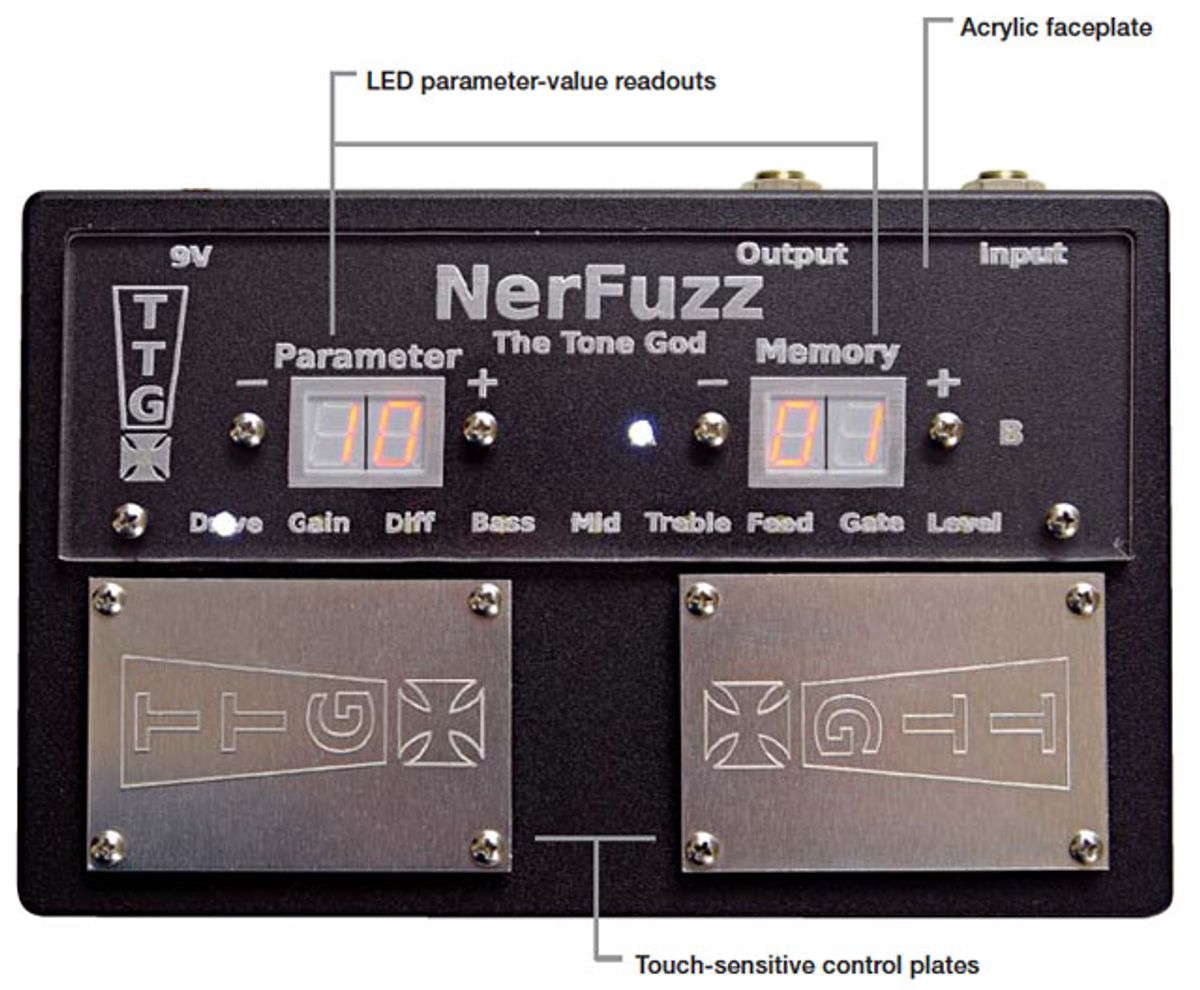
A fully programmable, 100-percent analog fuzz box, the NerFuzz offers nine different parameters that can be tweaked to access tones ranging from the subtly overdriven to the chaotically distorted.
| Download Example 1 Hard Rock Rhythm Distortion | |
| Download Example 2 Theremin High Setting | |
| Clips recorded with Gibson Les Paul through Fender Pro Junior miked with a Shure SM57 into Apogee Duet into GarageBand. | |
The NerFuzz’s more conventional look belies its stunning array of sonic possibilities. A fully programmable, 100-percent analog fuzz box, the NerFuzz offers nine different parameters that can be tweaked to access tones ranging from the subtly overdriven to the chaotically distorted. In other words, it’s a whole ensemble of fuzz pedals in one.
Box of Buzz
The NerFuzz has a sturdy black metal chassis measuring approximately 7 1/4" x 4 1/2" x 2 1/4". The face plate is laser etched, so the lettering will remain intact over time. The pedal is controlled by two touch-sensitive, Phillips-head screw mounted metal plates that eliminate the need for mechanical controls that can be damaged, get noisy, or degrade. The pedal also uses two numeric LED readouts to indicate the precise amount of effect.
On the back panel of the NerFuzz, you’ll find 1/4" input and output jacks and a power jack. While a low-profile 9V adapter is included, the unit will accept AC or DC input power of 9V to 24V at 100 mA, which makes it adaptable to different pedalboards’ power supplies.
The NerFuzz’s nine control parameters are Drive, Gain, Diff, Bass/Mid/Treble, Feed, Gate, and Level, most of which require no explanation. Diff activates a differential mode that, when adjusted in concert with the drive and gain levels, can induce octave, swelling, splattering, and other uncanny effects. Feed causes the NerFuzz to feed back upon itself, creating increasingly more anarchic sounds as the level is raised. Gate, of course, is a noise gate, which can be used to discourage unwanted humming from the pedal or a pickup.
Favored fuzz parameters can be stored in 20 footswitchable memory positions and further modified by Patches A and B. You can set these two patches to switch between, say, lead and rhythm sounds with a single foot tap, or between sick and sicker tones for particularly crazed lead work. When it’s powered on, the NerFuzz will automatically retrieve the previously selected memory location. Regardless, The Tone God recommends recording favorite settings the old-fashioned way, in a notebook, in the event they’re accidentally overwritten.
The NerFuzz has the distortion basics comprehensively covered with some superb tones. But it’s the pedal’s more freakish sounds that make it really intriguing.
True Grit
To audition the NerFuzz, I used a Gibson Les Paul and a Fender Pro Junior amp. I was initially frustrated by the lack of conventional control knobs on the NerFuzz. Having to cycle individually through the parameters and adjust their levels just felt tedious—and my first impression was that nothing could be easily done on the fly.
But once I delved into the pedal’s factory settings, I was super-impressed by the quality and range of sounds at my disposal. Memory 1, Patch A, a light-gain setting that is touch-sensitive, added fine grit and warmth to some jazzy altered chords and pseudo bebop lines. Memory 2 contained authentic-sounding rock rhythm and lead sounds on Patches A and B, respectively. Rock rhythm possessed a full-bodied gain that didn’t muddy on full chords. And the lead setting sounded both cutting and singing with a bit of added drive and treble. At the more saturated end of the spectrum, metal sounds with and without noise gate (stored in Memory 4, Patches A and B) were both pulverizing and detailed.
The NerFuzz has the distortion basics comprehensively covered with some superb tones. But it’s the pedal’s more freakish sounds that make it really intriguing. When I articulated and held a 1st-string Bb on Memory 5, Patch A, a startling series of octaves and fifths emerged. Playing the same note on Patch B, somehow produced a Bbm triad. There seemed to be a bit of randomness in the pitches generated by other notes, adding a unhinged quality to the sound.
Memory 8, Patch A, a fizzy sound, caused a note to start off constricted before erupting into a much fatter tone, and Memory 6, Patch B (Swell) created a similarly crazy blossoming effect. Another preset called Theremin High (Memory 10, Patch A) was especially fun to experiment with. This setting emitted a pedal tone, the pitch of which can be fluctuated with a guitar’s volume knob. (You can hear it for yourself at the beginning and end of the second audio example.)
Once I became acquainted with the NerFuzz by browsing through its factory presets, I found that it actually wasn’t too difficult to tweak the parameters and store my own settings. Because each parameter is adjustable in increments from 0 to 99, I came to appreciate the unit’s potential for shaping tones in very subtle ways. And although I wouldn’t necessarily try tweaking the parameters during a gig, it’s simple to prepare a menu of killer sounds to switch between onstage.
The Verdict
The Tone God’s NerFuzz is a superb boutique pedal that covers basic distortion sounds, plus some that are insane and otherworldly. It’s built uncommonly tough and should withstand years of even the heaviest use. With its numerically controlled parameters and memory banks, the pedal allows users to precisely recall their most inspiring settings. And while those new to programming more complex effects pedals might face a steep learning curve, the potential sonic rewards are abundant.
Buy if...
you want a tremendous range of distortion sounds—some very unconventional—in a single analog unit.
Skip if...
your distortion needs can be met in a basic, 3-knob stompbox.
Rating...
Street $399 - The Tone God - thetonegod.com |

